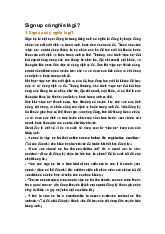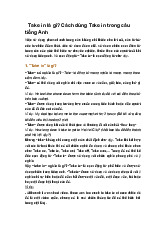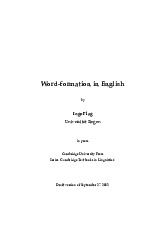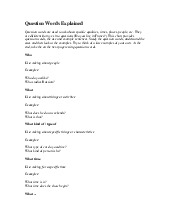



















Preview text:
Contents
Introduction: How to Use This Book
Part ONE Parts of Speech The Subject vii The Predicate Verbs 1
Action and Linking Verbs
Helping Verbs and Verb Phrases 3 Verbs in Contractions 7 Nouns 10
Common and Proper Nouns 13 Plural Nouns 16 Possessive Nouns 19 Compound Subjects 22 Compound Verbs 24 Nouns as Direct Objects 27 34 Nouns as Indirect Objects 38 Pronouns and Antecedents 41 Personal Pronouns
Pronouns in Contractions 45
Review of Verbs, Nouns, and Pronouns 48 Adjectives 52
Predicate Adjectives and Predicate Nouns 55 Adverbs 58
Forming Adverbs from Adjectives 61
Recognizing Adverbs and Adjectives 68 72 79 84 86 iii
Review of Adjectives and Adverbs 89 Prepositions 94 Prepositional Phrases 98 Conjunctions 102 Interjections 108
Review of Prepositions, Conjunctions, and 111 Interjections 115
Part TWO Sentence Composition 116
Characteristics of Good Sentences 117 Comparing Sentences 120 Writing Sentences 121 Revising Sentences 123 Clear, Forceful Sentences 123 Conciseness (Economy) 126
Clarity and Specificity 132 Varying Sentences 145 Unity 149
Part THREE Common Usage Errors 150
Problems with Sentence Structure 150 151 Simple Sentences Compound Sentences 152 Complex Sentences 155 Sentence Fragments 164 Run-on Sentences 171 Problems with Nouns 171 Plurals of Nouns 172 Possessives of Nouns 175 Problems with Verbs 175 177
Using the Correct Tense
Principal Parts of Verbs 181
Agreement of Subject and Verb 185 Troublesome Verb Pairs 189 Problems with Modifiers 189
Adjectives and Adverbs Confused 190 Double Negatives 191 Other Errors C O N T E N T S iv Problems with Pronouns 193 Personal Pronouns 193 Indefinite Pronouns 196 Possessive Pronouns 198 Problems with Punctuation 201 End Punctuation 201 The Comma 202 Quotation Marks 209 Punctuating Titles 210 Problems with Capitalization 214 In Letters 214 In Quotations 214 First Words 214
Proper Nouns and Proper Adjectives 215 Problems with Spelling 221
Frequently Misspelled Words 221 Words Often Confused 223
Seven Helpful Spelling Rules 224 Contractions 230
Part FOUR Basic Paragraph Composition 231 The Paragraph 232 A Note About Paragraph Length 233 Unity in the Paragraph 235 The Topic Sentence 239 The Clincher Sentence 242
Developing a Paragraph with Reasons 244 Arranging the Reasons 245
Arranging the Reasons—Another Look 248
Developing a Paragraph with Examples 249 Varying Sentence Beginnings 253 Index 259 C O N T E N T S v Introduction How To Use This Book
Grammar and Usage for Better Writing is a basic workbook that can provide a founda-
tion for further study in English grammar and usage. It will benefit students who are learn-
ing the essentials for the first time as well as those who wish to review concepts they have
previously learned. The premise of this book is that understanding how language works
enables us to use it more effectively. This skill can enhance our personal communications,
schoolwork, and professional lives.
The workbook is organized into four major parts. The parts in turn consist of brief
lessons, each with explanations, examples, and practice to ensure that students understand
the concepts being introduced. The book is structured sequentially, with the most basic
elements—the parts of a sentence—introduced in Part One, followed by the composition
of sentences in Part Two. Part Three focuses on some common problems that people en-
counter when using English, and it places more emphasis on applying the rules. Students
who are new to grammar study should begin with Part One and work through each section
in order; more advanced students who already know the parts of speech may want to start
with Part Two and use the first section for reference.
Once writers learn the parts of sentences and how they work together to determine the
meaning and effect of a sentence, they can begin to understand what good writing is all
about. Part Four is designed to help students make the transition from crafting sentences to
developing good paragraphs, the foundation for most kinds of writing. It serves as an in-
troduction to further study of rhetoric and composition.
Study the rules, review the examples, and look for more examples of good writing in
books, newspapers, magazines, Web sites, and other available sources. Complete the exer-
cises to practice what you have learned, but also remember to apply the rules whenever
you speak and write. The more you use what you learn in this book, the better and more
natural your use of the English language will be. In the end, you will be a stronger, more
effective speaker and writer. You’re on your way—good luck!
I N T R O D U C T I O N vii
Part ONE Parts of Speech
In a sentence, a word may play one of eight parts. It may be either 1. a noun, 5. an adverb, 2. a pronoun, 6. a preposition, 3. a verb, 7. a conjunction, or 4. an adjective, 8. an interjection.
These eight parts are known as the parts of speech.
We use the parts of speech to build sentences. For example, if we put together the noun
sunburn and the verb itches, we can make the following statement: Sunburn itches. N. V.
We can expand this statement by adding the adjective my: My sunburn itches. ADJ. N. V.
We can also add the adverb painfully:
My sunburn itches painfully. ADJ. N. V. ADV.
If we should want to ask a question, we can begin with a verb. Here is a question made
up of the verb is, the noun sunburn, and the adjective painful. Is sunburn painful? V. N. ADJ. 1
Of course, we can expand this question. For example, we can add the adverb usually.
Is sunburn usually painful? V. N. ADV. ADJ.
The system that our language uses to put parts of speech
together into sentences is known as grammar.
The first two lessons focus on the two basic parts of any sentence: the subject and the predicate. 2
PA R T S O F S P E E C H
Lesson 1 The Subject
A sentence has two parts: (1) a subject and (2) a predicate. This lesson deals with the subject.
The subject is the part of the sentence about which
something is told or asked.
The seats on the bus are very comfortable.
QUESTION: About what is the sentence telling something? ANSWER: The seats on the bus. SUBJECT: The seats on the bus.
Amelia Earhart disappeared over the Pacific.
QUESTION: About whom is the sentence telling something? ANSWER: Amelia Earhart. SUBJECT: Amelia Earhart.
Has your brother Tom found a summer job?
QUESTION: About whom is the sentence asking something? ANSWER: your brother Tom. SUBJECT: your brother Tom.
Position of the Subject
The subject is usually found at the beginning of the sentence, but it can also appear in other positions.
SUBJECT AT THE BEGINNING OF THE SENTENCE:
An experienced pilot was at the controls at the time of the crash.
SUBJECT AT THE END OF THE SENTENCE:
At the controls at the time of the crash was an experienced pilot. T H E S U B J E C T 3 SUBJECT WITHIN THE SENTENCE:
At the time of the crash, an experienced pilot was at the controls. Finding the Subject
A sure way to find the subject is to answer one or the other of these questions:
• About whom or about what is the sentence saying or asking something?
• Who or what is doing, or has done, or will do something? Question 1:
What is the subject of the following sentence?
The score at the end of the quarter was 12–12. Procedure:
Ask yourself: “About what is the sentence saying something?”
Obviously, The score at the end of the quarter. Answer:
The subject is The score at the end of the quarter.
(The subject tells about what the sentence is saying something.) Question 2:
What is the subject of the following sentence?
The orchestra members tuned their instruments. Procedure:
Ask yourself: “Who did something?” Answer:
The subject is The orchestra members.
(The subject tells who did something.) Question 3:
What is the subject of the following? Wait outside, please. Procedure:
Ask yourself: “Who is to wait outside?” Answer:
The subject is You (understood).
(You) wait outside, please. Note:
In an imperative sentence (a sentence expressing a command or mak-
ing a request), the subject You is not expressed but understood. Question 4:
What is the subject of the following?
Is the door to the basement locked? Procedure:
Ask yourself: “Is what locked?” Answer:
The subject is the door to the basement.
(The subject tells about what the sentence is asking something.) 4
PA R T S O F S P E E C H
EXERCISE 1. Write the subject in the space provided. Sample:
The apples in the fruit bowl were all sour.
The apples in the fruit bowl
1. Next to the hardware store is a ski shop.
2. Will your father drive us to the game?
3. Is the noise from the next room bothering you?
4. Our math teacher coaches the bowling team.
5. The bowling team is coached by our math teacher.
Simple Subject and Complete Subject
When a subject consists of more than one word, the main
word in that subject is called the simple subject.
The seats on the bus are very comfortable. SIMPLE SUBJECT: seats
The simple subject and the words that describe it are to-
gether known as the complete subject. COMPLETE SUBJECT: The seats on the bus Question:
Does a simple subject ever consist of more than one word? Answer:
Yes, especially if it is a name. For example:
The late Amelia Earhart was a pioneer in aviation. COMPLETE SUBJECT: The late Amelia Earhart SIMPLE SUBJECT: Amelia Earhart T H E S U B J E C T 5
EXERCISE 2. Write the complete subject in the C.S. space and the simple subject in the S.S. space. Sample:
The first reporters on the scene did not get all the facts. C.S.
The first reporters on the scene . S.S. reporters
Hint: You can be sure that you have correctly chosen the simple subject if you can prove
to yourself that it cannot be omitted. If The, first, and on the scene were omitted
from the C.S., above, the sentence would still make sense. But if reporters were
omitted, the sentence would not make sense. This proves that reporters is the sim- ple subject.
1. The famous Mona Lisa is a painting by Leonardo da Vinci. C.S. . S.S.
2. Did a letter from your sister come this morning? C.S. . S.S.
3. Farther up on the hill is a house with white shutters. C.S. . S.S.
4. Asleep in the crib was a six-month-old baby. C.S. . S.S.
5. My older brother is graduating in June. C.S. . S.S. 6
PA R T S O F S P E E C H
Lesson 2 The Predicate
Before we talk about the predicate, remember that
The subject is the part of the sentence about which
something is told or asked. Prices are higher. subject What Is the Predicate?
The predicate is the part of the sentence that tells or asks
something about the subject. Prices are higher . predicate
You can easily find the subject and the predicate of a sentence by asking two simple questions: Prices are higher. QUESTION 1:
About what is the sentence telling something? ANSWER: Prices. The subject is Prices. QUESTION 2:
What is the sentence saying about Prices? ANSWER: Prices are higher.
The predicate is are higher.
My sister Karen is waiting for us. QUESTION 1:
About whom is the sentence telling something? ANSWER: My sister Karen.
The subject is My sister Karen. T H E P R E D I C AT E 7 QUESTION 2:
What is the sentence saying about My sister Karen? ANSWER:
My sister Karen is waiting for us.
The predicate is is waiting for us. Was Andy angry? QUESTION 1:
About whom is the sentence asking something? ANSWER: Andy. The subject is Andy. QUESTION 2:
What is the sentence asking about Andy? ANSWER: Was Andy angry?
The predicate is Was angry.
Position of the Predicate
The predicate usually comes after the subject, but it can also appear in other positions. PREDICATE AFTER THE SUBJECT:
The parking lot is next to the stadium. S. P. PREDICATE BEFORE THE SUBJECT:
Next to the stadium is the parking lot. P. S.
PREDICATE PARTLY BEFORE AND PARTLY AFTER THE SUBJECT:
Is the parking lot next to the stadium? P. S. P.
EXERCISE 1. First draw a single line under the complete subject of the sentence.
Then, above the double line at the right, write the predicate. Samples: SUBJECT PREDICATE
The temperature dropped suddenly. dropped suddenly Has the plane landed? Has . . . landed
Under the tree lay many rotting apples. Under the tree lay 8
PA R T S O F S P E E C H
1. Has our teacher recovered from the flu?
2. Behind the wheel was my sister Maria.
3. How comfortable these new seats are!
4. Finally, the suspect surrendered to the police.
5. A flock of seagulls landed on the beach.
EXERCISE 2. Complete the sentence by adding a predicate. Samples: The apple was not ripe. A speck of dust flew into my eye. 1. The onion soup 2. Your suede jacket 3. Her new pen 4. The owner of the car 5. My desk at home T H E P R E D I C AT E 9
Lesson 3 Verbs
The main word in the predicate is called the verb. Here are a few examples:
1. The temperature dropped rapidly. PREDICATE: dropped rapidly VERB: dropped
2. José often visits exhibits at the natural history museum.
PREDICATE: often visits exhibits at the natural history museum VERB: visits
3. Have you no sense? PREDICATE: Have no sense VERB: Have
Without a verb, the predicate cannot tell or ask anything about the subject. For in- stance, if the verb
dropped is left out of the first sentence above, the resulting sentence
cannot convey any clear meaning: The temperature. . . rapidly. Question:
Does a verb ever consist of more than one word? Answer:
Yes, often. A verb may consist of one to four words: SENTENCE VERB They have no questions. have Do you have any questions? Do . . . have
We have been calling John all week. have been calling
His phone may have been disconnected. may have been disconnected 10
PA R T S O F S P E E C H
EXERCISE 1. Find the verb and write it in the blank space. Samples: Ben was at the door. was
They must have been treated badly. must have been treated
1. Mindy has a lot of friends.
2. The water is boiling in the microwave.
3. I should have listened to you.
4. He must have been pushed by someone in the crowd. 5. Did the light bother you?
EXERCISE 2. Write the simple subject in the S.S. space, the predicate in the P.
space, and the verb in the V. space. Samples:
The pond froze during the night. S.S. pond P. froze during the night V. froze Wash your hands. S.S. You (understood) P. Wash your hands V. Wash Did you hear the wind? S.S. You P. Did hear the wind V. Did hear 1. Comb your hair. S.S. P. V.
2. The bus will come at any minute. S.S. P. V. V E R B S 11
3. Has it been coming on time lately? S.S. P. V.
4. For some time, light rain has been S.S. falling. P. V.
5. It must have been raining since dawn. S.S. P. V.
6. In my pocket was the missing glove. S.S. P. V.
7. Fuel bills have been increasing S.S. every year. P. V.
8. The cold weather has been affecting S.S. the spring crops. P. V.
9. Does your remote control need fresh S.S. batteries? P. V.
10. Someone must have taken my books S.S. by mistake. P. V. 12
PA R T S O F S P E E C H
Action and Linking Verbs ACTION VERBS
What Is an Action Verb?
An action verb is a verb that expresses action.
There are two kinds of action verbs:
1. Verbs that express physical action—action that can be seen or heard:
The car skidded, left the road, and smashed into a telephone pole.
(Skidded, left, and smashed express physical action.)
2. Verbs that express mental action—action that takes place in the mind and
therefore cannot be seen or heard:
We believed and trusted them because we knew them.
(Believed, trusted, and knew express mental action.)
EXERCISE 1. If the italicized verb expresses physical action, write P in the space
provided. If it expresses mental action, write M. Samples: Pat tagged the runner. P
Did you understand the lesson? M
1. I forgot the combination. 2. Open a window. 3. Who rang the bell?
4. He considers me his best friend.
5. We are hoping for the best this season. LINKING VERBS
Not all verbs are action verbs. The verb is in the following sentence does not express
action. It is a linking verb. Jordan is angry at us. L.V. V E R B S 13



